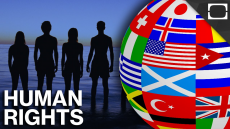
Email: ZYVC057@live.rhul.ac.uk
Total Article : 213
About Me:I'm a graduate student studying International Criminal Law and first started writing for King's News almost 4 years ago! My hobbies include reading, travelling and charity work. I cover many categories but my favourite articles to write are about mysteries of the ancient world, interesting places to visit, the Italian language and animals!

As with many things, the field of Human Rights was heavily shaped by the historical context in which it was born. After WW2 came to an end and Human Rights were at the forefront of discussions, another global crisis emerged in the form of the Cold War. This period is characterised by both a war of ideologies and power which were manifested via proxy wars.
Even the field of Human Rights became territory for ideological conflict. The Western block was more prone to civil and human rights where Communist nations of the Soviet Bloc were more worried about economics. Thus the clash between capitalism and communism played out in discussions regarding Human Rights. The Capitalism model says all individuals will have the right to determine economy (free markets) and that the State should take a back seat. Whereas, according to Communism, the State has a central role to play in terms of health, housing, social responsibility and as such individual rights should be placed below those of the State. The world was hence divided into two blocks.
In 1948 the UN Declaration of HR (UDHR) was adopted. There were only 56 states members at the same time. The drafters came from Lebanon, USSR, Australia, Chile, Canada, US, France, China, UK. And Elinor Roosevelt was the chair of drafting committee.
The UDHR did not differentiate between normative values of civil and political rights and economic, social and cultural rights. By the time the committee member reached the second stage, the document, the cold war had started. As mentioned, the Western and European blocks had different priorities and only argued to include civil and political rights saying that economic, social and cultural rights are not rights that the State is responsible for. The Communist Bloc said that electoral ballet should not be the right which is prioritised but as a State each nation must guarantee economic, social and cultural rights. At the time, there was the perception that rights can be overseen by a Human Rights committee and the Western Bloc argued that this committee could easily track civil and political rights such as the right to vote, but it could not track economic, social and cultural rights in the same way. As a result, two treaties were adopted in 1952 and entered into force in 1966. The two treaties are Covenants on Human Rights.
Today, most European nations recognise economic, social and cultural rights as Human Rights and accept that both sets of Human Rights should be respected by States. However even to date the U.S. even today has not ratified the economic rights and China has not ratified civil and political rights.
The international bill of human rights as we know it today refers collectively to three documents:
UDHR 1948
ICCPR 1966
ISESCR 1966
Despite the ideological war which characterised the years following WW2, States were able to act accordingly and adopt two separate Conventions in the hope of accomplishing some legal commitment in despite of the set back. These three documents aside, we have seven other Human Rights treaties which are known as core human rights treaties.
IMAGE SOURCE: https://www.youtube.com/watch?v=pnoWFZ29xSE

0 Comment:
Be the first one to comment on this article.